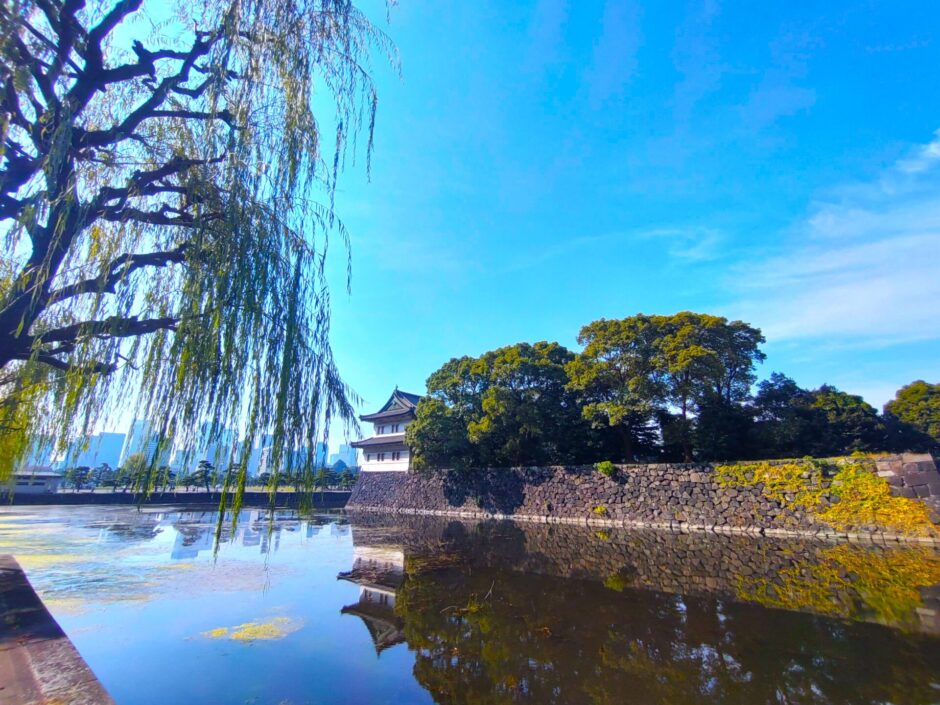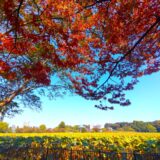【Outline of the Plaza in front of the Imperial Palace】
For bus tours, I believe they will bring you to the Imperial Palace Plaza in the outer gardens of the Imperial Palace.
![The Imperial Palace (Outer Gardens of the Imperial Palace, Ruins of Edo Castle, East Gardens) [Tokyo] DSC 0357 1024x768 - The Imperial Palace (Outer Gardens of the Imperial Palace, Ruins of Edo Castle, East Gardens) [Tokyo]](https://japan-shrine.info/wp-content/uploads/DSC_0357-1024x768.jpg)
The Imperial Palace Plaza is a spacious, green, and comfortable place in the middle of Tokyo. For those who have never been there before, it is a strange feeling to be surrounded by so many skyscrapers in the middle of a big city with such a wide view of the sky, and yet not feel oppressed. Tokyo Sightseeing bus tours will take you to the Imperial Palace Square, but they will not take you inside the Palace, so if you want to see the gardens, you should check the contents of the tour.
![The Imperial Palace (Outer Gardens of the Imperial Palace, Ruins of Edo Castle, East Gardens) [Tokyo] DSC 0355 1024x768 - The Imperial Palace (Outer Gardens of the Imperial Palace, Ruins of Edo Castle, East Gardens) [Tokyo]](https://japan-shrine.info/wp-content/uploads/DSC_0355-1024x768.jpg)
The main gate iron bridge (Nijubashi) of the Special Historic Site Edo Castle Ruins Historic Site is located near the Imperial Palace plaza.
![The Imperial Palace (Outer Gardens of the Imperial Palace, Ruins of Edo Castle, East Gardens) [Tokyo] DSC 0358 1024x768 - The Imperial Palace (Outer Gardens of the Imperial Palace, Ruins of Edo Castle, East Gardens) [Tokyo]](https://japan-shrine.info/wp-content/uploads/DSC_0358-1024x768.jpg)
After seeing the Imperial Palace Plaza, a stop on the way home is the statue of Masanari Kusunoki near the bus stop.
![The Imperial Palace (Outer Gardens of the Imperial Palace, Ruins of Edo Castle, East Gardens) [Tokyo] DSC 0361 1024x768 - The Imperial Palace (Outer Gardens of the Imperial Palace, Ruins of Edo Castle, East Gardens) [Tokyo]](https://japan-shrine.info/wp-content/uploads/DSC_0361-1024x768.jpg)
It depicts the heroic figure of Masanari Kusunoki, who overthrew the Kamakura Shogunate, as he greeted Emperor Godaigo on his return from Oki Island on the road to Hyogo. The statue was presented to the Imperial Household Agency by Sumitomo (now Sumitomo Mitsui Group) in 1897, and it took 10 years from its planning to its completion.
![The Imperial Palace (Outer Gardens of the Imperial Palace, Ruins of Edo Castle, East Gardens) [Tokyo] DSC06497 1024x768 - The Imperial Palace (Outer Gardens of the Imperial Palace, Ruins of Edo Castle, East Gardens) [Tokyo]](https://japan-shrine.info/wp-content/uploads/DSC06497-1024x768.jpg)
【Outline of the ruins of Edo Castle in the Imperial Palace】
To access the ruins of Edo Castle and the East Gardens, you must pass through the Otemon Gate. Before that, the police will inspect your belongings, so if possible, refrain from entering with carrycases. After passing through the Ote-mon Gate and the Ote-san-mon Gate, you will see the Hyakunin-banjo on your left and the Nakanomon Ruins on your right.
![The Imperial Palace (Outer Gardens of the Imperial Palace, Ruins of Edo Castle, East Gardens) [Tokyo] DSC 0312 1024x768 - The Imperial Palace (Outer Gardens of the Imperial Palace, Ruins of Edo Castle, East Gardens) [Tokyo]](https://japan-shrine.info/wp-content/uploads/DSC_0312-1024x768.jpg)
The Hyakunin-bansho was an important guard post that protected the Ote San-no-mon Gate, a key point leading to the castle’s Honmaru and Ninomaru. The Hyakunin-banjo was the largest checkpoint in Edo Castle, and was guarded in shifts by four groups: the Negori-gumi, the Iga-gumi, the Kouga-gumi, and the Twenty-five Horsemen (廿五騎組), known as the Hyakunin-gumi (鉄砲百人組). 100 men guarded each, hence the name Hyakunin-banjo.
![The Imperial Palace (Outer Gardens of the Imperial Palace, Ruins of Edo Castle, East Gardens) [Tokyo] DSC 0334 1024x768 - The Imperial Palace (Outer Gardens of the Imperial Palace, Ruins of Edo Castle, East Gardens) [Tokyo]](https://japan-shrine.info/wp-content/uploads/DSC_0334-1024x768.jpg)
If you go up ahead from the Nakanomon ruins, you will find the ruins of Edo Castle. The ruins of Edo Castle are the remains of one of the largest castle towers in Japan, measuring about 60 meters in height. Unfortunately, it was burned down and lost during the Meireki no Taika (Great Fire of Meireki) in 1657. It was a huge fire that burned most of Edo in about two days.
![The Imperial Palace (Outer Gardens of the Imperial Palace, Ruins of Edo Castle, East Gardens) [Tokyo] DSC 0321 1024x768 - The Imperial Palace (Outer Gardens of the Imperial Palace, Ruins of Edo Castle, East Gardens) [Tokyo]](https://japan-shrine.info/wp-content/uploads/DSC_0321-1024x768.jpg)
Although there are almost no historical buildings, the park is currently planted with plants and trees that add color to the four seasons. The flowers that bloom each season are beautiful, and you can enjoy a sense of tranquility that is hard to believe that you are in the middle of Tokyo. If you are not interested in history or castles, there is nothing to see but the castle keep, so do not expect too much and just enjoy it as a park. (This is not a place I would recommend to foreigners who want to see historical buildings in Japan.)
![The Imperial Palace (Outer Gardens of the Imperial Palace, Ruins of Edo Castle, East Gardens) [Tokyo] DSC 0317 1024x768 - The Imperial Palace (Outer Gardens of the Imperial Palace, Ruins of Edo Castle, East Gardens) [Tokyo]](https://japan-shrine.info/wp-content/uploads/DSC_0317-1024x768.jpg)
【Outline of the East Gardens of the Imperial Palace】
The highlights of the East Gardens of the Imperial Palace are the Ninomaru Garden and Suwa-jaya Tea House. The Ninomaru Garden is a restored garden based on a garden map from the era of the ninth shogun, Ieshige Ieshige, and has a pond with a graceful swimming pool filled with a white-fringed goatfish. The best time to visit is from mid to late April when the azaleas are in full bloom, but you can also enjoy the flowers from spring to summer and the leaves in autumn.
![The Imperial Palace (Outer Gardens of the Imperial Palace, Ruins of Edo Castle, East Gardens) [Tokyo] DSC 0339 1024x768 - The Imperial Palace (Outer Gardens of the Imperial Palace, Ruins of Edo Castle, East Gardens) [Tokyo]](https://japan-shrine.info/wp-content/uploads/DSC_0339-1024x768.jpg)
Suwa-teahouse was a teahouse located near the current Fukiage Gyoen (Imperial Palace) during the Edo period, and was built in the sukiya-style shoin teahouse style. It was rebuilt in 1902 and moved here when the East Gardens of the Imperial Palace was renovated because of its elegant appearance as a teahouse-style building of the Meiji period.
![The Imperial Palace (Outer Gardens of the Imperial Palace, Ruins of Edo Castle, East Gardens) [Tokyo] DSC 0342 1024x768 - The Imperial Palace (Outer Gardens of the Imperial Palace, Ruins of Edo Castle, East Gardens) [Tokyo]](https://japan-shrine.info/wp-content/uploads/DSC_0342-1024x768.jpg)
【Imperial Palace Nearby attractions】
Tokyo Station, Yasukuni Shrine, Tsukudo Shrine
【Imperial Palace Access】
Manager’s comment.
It is a large park, so it is a long walk. It is recommended to visit during the rest of the year, as Tokyo is very hot in the summer. The Edo Castle Ruins is a park. It is not recommended for foreign visitors who want to see historical buildings in Japan, so please gather information before visiting.
1-1 Chiyoda, Chiyoda-ku, Tokyo 100-8111, Japan
*There is no parking available. Use nearby parking.
 Tour of Japanese shrines and temples
Tour of Japanese shrines and temples 

![The Imperial Palace (Outer Gardens of the Imperial Palace, Ruins of Edo Castle, East Gardens) [Tokyo] 23740271 m 520x300 - The Imperial Palace (Outer Gardens of the Imperial Palace, Ruins of Edo Castle, East Gardens) [Tokyo]](https://japan-shrine.info/wp-content/uploads/23740271_m-520x300.jpg)
![The Imperial Palace (Outer Gardens of the Imperial Palace, Ruins of Edo Castle, East Gardens) [Tokyo] DSC 1621 1 520x300 - The Imperial Palace (Outer Gardens of the Imperial Palace, Ruins of Edo Castle, East Gardens) [Tokyo]](https://japan-shrine.info/wp-content/uploads/DSC_1621-1-520x300.jpg)
![The Imperial Palace (Outer Gardens of the Imperial Palace, Ruins of Edo Castle, East Gardens) [Tokyo] DSC 2361 150x150 - The Imperial Palace (Outer Gardens of the Imperial Palace, Ruins of Edo Castle, East Gardens) [Tokyo]](https://japan-shrine.info/wp-content/uploads/DSC_2361-150x150.jpg)
![The Imperial Palace (Outer Gardens of the Imperial Palace, Ruins of Edo Castle, East Gardens) [Tokyo] DSC 1706 1 150x150 - The Imperial Palace (Outer Gardens of the Imperial Palace, Ruins of Edo Castle, East Gardens) [Tokyo]](https://japan-shrine.info/wp-content/uploads/DSC_1706-1-150x150.jpg)
![The Imperial Palace (Outer Gardens of the Imperial Palace, Ruins of Edo Castle, East Gardens) [Tokyo] DSC 0235 150x150 - The Imperial Palace (Outer Gardens of the Imperial Palace, Ruins of Edo Castle, East Gardens) [Tokyo]](https://japan-shrine.info/wp-content/uploads/DSC_0235-150x150.jpg)
![The Imperial Palace (Outer Gardens of the Imperial Palace, Ruins of Edo Castle, East Gardens) [Tokyo] DSC 1265 150x150 - The Imperial Palace (Outer Gardens of the Imperial Palace, Ruins of Edo Castle, East Gardens) [Tokyo]](https://japan-shrine.info/wp-content/uploads/DSC_1265-150x150.jpg)

